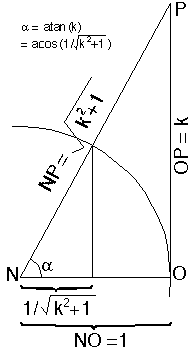 |
I hope this makes it more obvious that alpha = atan(k) = acos(1/sqrt(k^2+1)) recall the expression for r coordinate of Q was
Recall the z coordinate of Q was
So, as asserted before, Q's cylindrical coordinates
|
 |
I hope this makes it more obvious that alpha = atan(k) = acos(1/sqrt(k^2+1)) recall the expression for r coordinate of Q was
Recall the z coordinate of Q was
So, as asserted before, Q's cylindrical coordinates
|
My thanks to Ron Winther, Kirk Bresniker and Axel Harvey from Sci.Math for helping me out with the trigonometry.